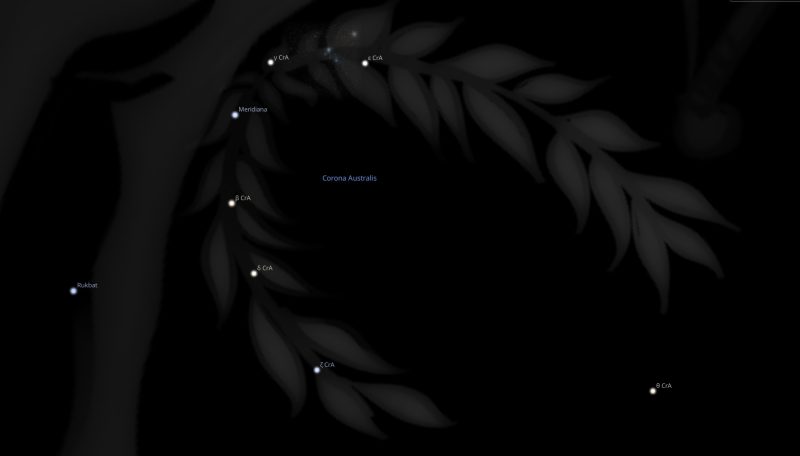FIXED STARS: Major Stars | 1000+ Stars | Constellations | About
Constellation Corona Australis, the Southern Crown, is a southern constellation bordering Sagittarius, Scorpius, Ara and Telescopium.Corona Australis is one of the 48 constellations listed by Ptolemy in the 2nd century and remains one of the 88 modern constellations. It spans 10 degrees of the zodiac in the Sign of Capricorn.
Abbreviation: CrA
Genitive: Coronae Australis
Corona Australis Constellation Stars
| 2000 | 2050 | Star | Name | Sp. Class | Mag. | Orb |
|---|---|---|---|---|---|---|
| 06♑32 | 07♑14 | θ CrA | G5 | 4.62 | 1°00′ | |
| 12♑02 | 12♑44 | ε CrA | F3 | 4.83 | 1°00′ | |
| 12♑20 | 13♑03 | ζ CrA | A0 | 4.74 | 1°00′ | |
| 13♑34 | 14♑16 | δ CrA | K1 | 4.57 | 1°10′ | |
| 13♑37 | 14♑19 | γ CrA | F7 | 4.23 | 1°20′ | |
| 14♑03 | 14♑46 | β CrA | K0 | 4.10 | 1°20′ | |
| 14♑08 | 14♑50 | α CrA | Meridiana | A0 | 4.11 | 1°20′ |
Corona Australis Astrology
Robson
Legend. This is said by some authors to represent a cast-off garland once worn by Sagittarius, while others consider that it represents the wheel upon which Ixion was tormented because of his insult to Juno. This constellation has been called Uraniscus, because of its resemblance to the palate or roof of the mouth.
Influence. According to Ptolemy the bright stars are like Saturn and Jupiter. It is said to bring unforeseen troubles, but to give a position of authority. [1]
Allen
Corona Australis, the Southern Crown,
often qualified by other synonymous adjectives, austrina, meridiana, meridionalis, or notia, is an inconspicuous constellation, although accepted in Ptolemy’s time as one of the ancient forty-eight. On modern maps its location is close to the waist of Sagittarius, on the edge of the Milky Way.
The Germans know it as the Südliche Krone; the French, as the Couronne Australe; and the Italians, as the Corona Australe.
Hipparchos is said to have known it as Κηρυκεῖον, the Caduceus, or Herald’s Wand of Peace, but this is not found in his Commentary. Ptolemy called it Στεφάνος νοτίος, the Southern Wreath.
Gould assigns to it forty-nine stars, many more than even Heis does to its much more celebrated and noticeable counterpart in the north. Its lucida, the 4th‑magnitude α, at the eastern edge of the constellation, is Alfecca meridiana in the Latin translation of Reduan’s Commentary. [1]
References
- Fixed Stars and Constellations in Astrology, Vivian E. Robson, 1923, p.39-40.
- Star Names: Their Lore and Meaning, Richard H. Allen, 1889, p.172-174.

![Corona Australis Constellation [Urania’s Mirror]](https://astrologyking.com/wp-content/uploads/constellation-sagittarius.jpg)